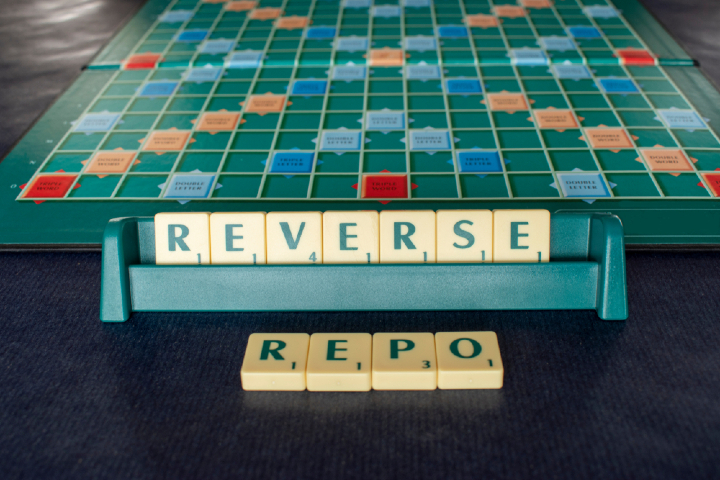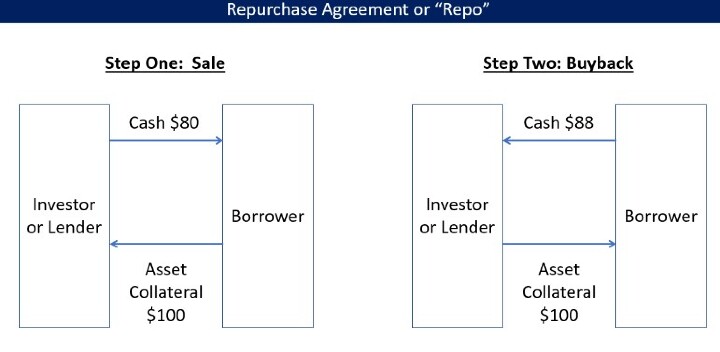
 Data Structure
Data Structure Networking
Networking RDBMS
RDBMS Operating System
Operating System Java
Java MS Excel
MS Excel iOS
iOS HTML
HTML CSS
CSS Android
Android Python
Python C Programming
C Programming C++
C++ C#
C# MongoDB
MongoDB MySQL
MySQL Javascript
Javascript PHP
PHP
- Selected Reading
- UPSC IAS Exams Notes
- Developer's Best Practices
- Questions and Answers
- Effective Resume Writing
- HR Interview Questions
- Computer Glossary
- Who is Who
Reverse Repo Rate
What is Reverse Repo Rate?
The Reverse Repo Rate is the interest rate at which the Central Bank of India, the Reserve Bank of India (RBI), borrows money from commercial banks for a short term. The reverse repo rate and repo rate form a pair of important monetary tools for controlling market inflation and liquidity. It must be noted that the repo rate, which is opposite to the reverse repo rate, is the interest the commercial banks pay to RBI when they borrow money from the latter for a short term.

Banks also voluntarily park their excess money at RBI because they get attractive interest rates and have the security that their money is in safe hands. Monetary Policy Committee (MPC), headed by the RBI Governor decides the Reverse Repo Rate. The decision is usually taken in the bi-monthly meeting of the Committee.
Banks also voluntarily park their excess money at RBI because they get attractive interest rates and have the security that their money is in safe hands. Monetary Policy Committee (MPC), headed by the RBI Governor decides the Reverse Repo Rate. The decision is usually taken in the bi-monthly meeting of the Committee.
Difference Between Repo Rate and Reverse Repo Rate
| Repo Rate | Reverse Repo Rate |
|---|---|
| The repo rate is the rate of interest commercial banks have to pay when they borrow money from the RBI. It is usually considered more applicable in controlling the money supply and liquidity in an economy. | The reverse repo rate is the opposite of this. The reverse repo rate is the interest RBI pays to commercial banks for depositing their surplus money at the RBI. |
| while in the case of repo rate, the commercial banks borrow the money from the RBI. | In the case of reverse repo rate,the RBI borrows money from commercial banks. |
| A high repo rate results in more liquidity in the market. As the interest rate on loans from RBI is hiked, the commercial banks pass the loan interest more to the customers, thereby increasing the interest rate on the money supply in the market. | A high reverse repo rate squeezes the money supply in the market. As commercial banks get more interest from the RBI, they stop lending money to customers in the market and park it at RBI. This dries the money market in the economy. |
| A repo rate is higher than the reverse repo rate. | the reverse repo rate is always lower than the repo rate. |
Example of Repo Rate

It is notable that money transactions keep going on in both directions. Both of these transactions take place for a short-term period and rates are revised according to the conditions of the market, required liquidity, and state of inflation in the market.
Impact of Reverse Repo Rate on Economy
The reverse repo rate has a notable effect on the economy.
Flow of money When the reverse repo rate is increased by the RBI, commercial banks are enticed to park their money at RBI. So, the availability of money in the market dries up. This stops the flow of money in the economy and the value of Rupee goes up.
To control inflation The RBI may also use the reverse repo rate to control inflation in the economy. When inflation needs to be lowered, the RBI hikes the reverse repo rate. This results in strengthening the rupee which leads to a reduction in inflation.
Increase in inflation When the inflation is to be lowered, the RBI cuts the reverse repo rate which leads to the weakening of the value of the rupee leading to an increase in inflation.
Impact in property market The hike of the reverse repo rate is felt in the property market. As commercial banks prefer to park their money at the RBI when the reverse repo rate is increased, they will offer fewer property loans to the customers. Therefore, property loans will turn costlier and the effect may be seen in the real estate market.
Loans are costlier In general, when the reverse repo rate is increased, the loans get costlier. So, the reverse repo rate can be used to control the interests of loans in the market. If the cost of loans becomes unbearable, the customers may default in paying back the loans in large numbers. The property market, therefore, may get crushed within a few months when the reverse repo rate is hiked too much.
Property market bubble bursts This is what usually happens in the housing property market bubble bursts. The entire loan mechanism breaks down and banks become unable to recover the loans they have provided to customers. This lets the central banks reconsider the reverse repo rate immediately.
Reverse Repo Rate and Money Flow Relation
As mentioned earlier, an increase in the reverse repo rate lets commercial banks park more of their money at the RBI. This means that the commercial banks will deposit most of their money at the RBI instead of providing them as loans to the customers. Therefore, the availability of money in the markets will come down. In other words, an increase in the reverse repo rate will dry up the money flow in the market.
On the other hand, a cut in the reverse repo rate will drive commercial banks away from depositing the money at the RBI because the interest will be low. This will let the commercial banks put their money in other money market instruments.
The loans provided to customers will also rise because a larger amount of money will be left idle in the hands of commercial banks. Therefore, a cut in the reverse repo rate will make the markets more liquid.
Conclusion
The reverse repo rate is one of the most important and powerful tools in the hands of the central banks to control the inflation and money supply in an economy. It is used to strengthen the currency too. As the reverse repo rate is considered ideal for availing loans from the RBI, commercial banks always keep an eye on it. That is probably why economists value the reverse repo rate so highly.
FAQs
Qns 1. What is the reverse repo rate?
Ans. The reverse repo rate is the interest rate at which the central bank of India, the Reserve Bank of India (RBI), borrows money from commercial banks for a short term
Qns 2. Is the reverse repo rate always lower than the repo rate?
Ans. Yes. The reverse repo rate is always lower than the repo rate.
Qns 3. Does an increase in the reverse repo rate increase the money supply in the market?
Ans. No. An increase in the reverse repo rate reduces the money supply in the market.

